 |
 |

 |
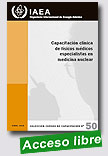 |
Capacitación clínica de físicos médicos especialistas en medicina nuclear
OIEA Colección Cursos de Capacitación, 2013, 288 p.
El objetivo del programa de capacitación clínica para físicos médicos especialistas en medicina nuclear es formar a un profesional independiente dedicado al estudio a lo largo de alto grado de profesionalidad y seguridad.
El programa de capacitación clínica trata de ayudar a conseguir este objetivo mediante lo siguiente: suministro de esta guía detallada sobre la capacitación clínica y de los apéndices I a V; |
creación de una estrategia de aplicación para posibilitar una capacitación clínica eficaz. Formación de la base de una norma de cualificación nacional o regional (enseñanza y capacitación clínica); prestación de asistencia a los órganos y departamentos nacionales para impartir el programa de capacitación mediante un programa experimental; promoción de la mejora de la calidad del programa; y fortalecimiento de la capacidad nacional para sostener un programa de capacitación clínica de esta índole después de la implantación inicial.
Extraído de: http://www-pub.iaea.org/MTCD/Publications/PDF/TCS50s_web.pdf
|
 |
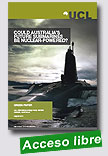 |
Could Australia´s Future Submarine be Nuclear-Powered ?
University College London International Energy Policy Institute (Australia), August 2013, 34 p.
The decision on whether Australia should deploy, through a variety of procurement options, conventional and/or nuclear-powered submarines will be determined by the Australian Government in accordance with its current submarine acquisition process. Concise arguments have been made by others for the need for at least part of the new submarine fleet to be nuclear-powered. We concur with such thinking. However,
|
these previous studies did not explore the key issues that will
need to be addressed if Australia is to have the capability to operate and maintain nuclear-powered submarines. This paper seeks to highlight those issues and addresses the question: “What would it take for Australia to develop a nuclear powered submarine capability?” Developing a nuclear-powered submarine capability in Australia involves identifying
the necessary infrastructure, workforce, legislative and regulatory (both national and international) requirements. This report finds eight key issues in relation to meeting these requirements, as well as a number of strategic points requiring policy focus. There is a small, but growing, presence in Australia of subsidiaries of major international engineering companies with expertise across the nuclear and submarine supply chain. These companies may be willing to increase their capacity to support a nuclearpowered submarine capability in Australia. However, further support will be required from Australia’s allies, regardless of the final choice of submarine design.
Extraído de:
http://www.ucl.ac.uk/australia/files/could-australias-future-submarines-be-nuclear-powered
|
 |
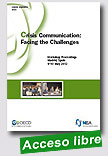 |
Crisis Communication: Facing the Challenges
Nuclear Energy Agency (NEA), 06/05/12, 240 p.
As manifested by an increasingly globalised media, a nuclear accident anywhere quickly becomes a potential concern for people everywhere. It is therefore of prime importance that nuclear regulators’ communication strategies take into consideration the expectations and concerns of the public and provide sound information not only for the people of the affected country, but also for citizens worldwide. Public trust is a key element in being able to do so effectively and of particular
|
importance when there are consequences for people or the environment. International co-operation can play a fundamental role in helping to improve crisis communication on national and global scales in the event of a nuclear accident or radiological emergency. These proceedings contain the papers, recommendations and conclusions of the workshop, which was attended by over 180 experts from 27 countries and 6 international organisations.
Extraído de:
http://www.oecd-nea.org/tools/publication?query=&div=
&lang=&period=6m&sort=title&filter=1 |
 |
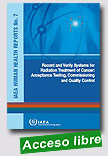 |
This publication serves as a useful guide for medical physicists in radiation oncology, radiation oncologists and radiation therapists, ensuring accuracy, safety and quality in radiation therapy. Record and verify systems (RVSs) were developed to reduce the risk of treatment errors in radiation oncology. These have recently evolved into complete radiotherapy information |
management systems that interface with imaging systems, treatment planning computers, and treatment delivery systems. To function as intended, RVSs must be subject to a comprehensive quality assurance (QA) programme. This publication provides practical guidelines for a comprehensive QA programme and its implementation. It describes the QA programme, including acceptance tests and the commissioning process that should be used in conjunction with the installation of a new RVS. It is also highlighted that some of the tests performed at installation must be repeated regularly as part of the periodic quality control checks.
Extraído de:
http://www-pub.iaea.org/books/IAEABooks/8941/Record-and-Verify-Systems-for-Radiation-Treatment-of-Cancer-Acceptance-Testing-Commissioning-and-Quality-Contro
|
 |
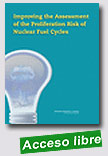 |
Improving the Assessment of the Proliferation Risk of Nuclear Fuel Cycles
Committee on Improving the Assessment of the Proliferation Risk of Nuclear Fuel Cycles; National Academy of Sciences, 2013, 78 p.
The material that sustains the nuclear reactions that produce energy can also be used to make nuclear weapons—and therefore, the development of nuclear energy is one of multiple pathways to proliferation for a non-nuclear weapon state. There is a tension between the development of future nuclear fuel |
cycles and managing the risk of proliferation as the number of existing and future nuclear energy systems expands throughout the world. As the Department of Energy (DOE) and other parts of the government make decisions about future nuclear fuel cycles, DOE would like to improve proliferation assessments to better inform those decisions.
Extraído de: http://www.nap.edu/catalog.php?record_id=18335
|
 |
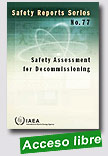 |
Safety Assessment for Decommissioning
IAEA Safety Reports Series, 2013, 133 p.
The international project on evaluation and demonstration of safety during decommissioning of facilities using radioactive material (DeSa), launched by the IAEA in 2004, helps to ensure that specific guidance on the safety assessment in the context of the decommissioning of nuclear facilities is provided. This publication presents the outcomes of the work carried out in fulfilling the action plan through the DeSa Project. The main features of the process have been summarized and overall
|
recommendations on producing, reviewing and implementing the safety assessment have been made. They are supported by specific recommendations contained in Annexes I–III.
Extraído de:
http://www-pub.iaea.org/books/IAEABooks/8891/Safety-Assessment-for-Decommissioning
|
 |
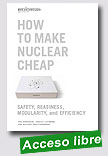
|
How to Make Nuclear Cheap: Safety, Readiness, Modularity, and Efficiency
Breakthrough Institute, July 7, 2013, 70 p.
Nuclear energy is at a crossroads. It supplies a substantial share of electricity in many developed economies — 19 percent in the United States, 35 percent in South Korea, 40 percent in Sweden, 78 percent in France — but these figures may decline as reactors built in the 1960s, 1970s, and 1980s retire. Meanwhile, developing countries are increasingly turning to nuclear to meet rapidly growing energy demand and to reduce |
pollution. China is currently building 28 reactors and has plans for dozens more; 11 are under construction in Russia, seven in India. Nevertheless, fossil fuels remain dominant worldwide, with coal the reigning king and natural gas production booming. The central challenge for nuclear energy, if it is to become a greater portion of the global electricity mix, is to become much cheaper.
Extraído de:
http://thebreakthrough.org/images/pdfs/Breakthrough_
Institute_How_to_Make_Nuclear_Cheap.pdf
|
 |
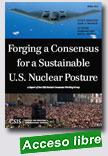 |
Overcoming Barriers in the Implementation of Environmental Remediation Projects
IAEA Nuclear Energy Series, 2013, 58 p.
Environmental remediation has been in existence for decades and has developed a tremendous body of practical and scientific knowledge. Responding to the needs of Member States, the International Atomic Energy Agency has initiated an environmental remediation project to address radioactive contamination found in soils and waters. This publication discusses the drivers for environmental remediation as well as the major obstacles confronted by any remediation operation |
and how to overcome those obstacles. It includes a number of potential strategies that may provide effective remediation outcomes and that have been deemed to be cost-effective by Member States. Implementers of an environmental remediation programme as well as regulators will benefit from the information and guidance provided in this publication.
Extraído de:
http://www-pub.iaea.org/books/IAEABooks/8960/Overcoming-Barriers-in-the-Implementation-of-Environmental-Remediation-Projects
|
 |
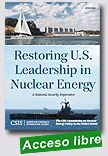 |
Restoring U.S. Leadership in Nuclear Energy: A National Security Imperative
Center for Strategic and International Studies (CSIS), July 2013, 90 p.
America’s nuclear energy industry is in decline. Low natural gas prices, financing hurdles, failure to find a permanent repository for high-level nuclear waste, reactions to the Fukushima accident in Japan, and other factors are hastening the day when existing U.S. reactors become uneconomic, while making it increasingly difficult to build new ones. Two generations after the United States took this wholly new and highly sophisticated
|
technology from laboratory experiment to successful commercialization, our nation is in danger of losing an industry of strategic importance and unique promise for addressing the environmental and energy security demands of the future.
Since March 2011, the Nuclear Energy Program at CSIS has engaged a high-level commission and asked dozens of experts whether or not nuclear energy should be a national priority and whether or not U.S. leadership matters. The program has focused on identifying the challenges facing nuclear energy and recommendations for future action. The result is the report “Restoring U.S. Leadership in Nuclear Energy: A National Security Imperative”, which will be used as a basis for conversations with policymakers, industry representatives, and outside experts.
Extraído de:
http://csis.org/event/restoring-us-leadership-nuclear-energy-national-security-imperative
|
 |
|
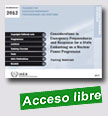
|
Considerations in Emergency Preparedness and Response for a State Embarking on a Nuclear Power Programme - Training Materials
IAEA, 2013, s. p.
The aim of these training materials is to provide a practical tool for emergency planning for a State embarking on a nuclear power programme, and to fulfil, in part, functions assigned to the IAEA under the Convention on Assistance in the Case of a
|
Nuclear Accident or Radiological Emergency (the Assistance Convention). Under Article 5.a(ii) of the Assistance Convention, one function of the IAEA is to collect and disseminate to States Parties and Member States information concerning methodologies, techniques and available results of research relating to such emergencies.
One of the concerns associated with nuclear power is the possibility that a State embarking on a nuclear power programme might not have sufficient capabilities and therefore would not be adequately prepared to respond to a radiation emergency caused by severe accident conditions.
Protecting the public, the environment and property in the event of a failure of any level of defence in depth is the most important safety objective. A robust framework for emergency preparedness and response to a radiation emergency forms the last level of defence in depth and, as such, must be developed and implemented by any State embarking on a nuclear power programme, using best international practices. The establishment of capabilities and arrangements for emergency preparedness and response to severe accident conditions is one of the principal tasks in the development of a national infrastructure for nuclear power. State of the art emergency preparedness and response is a key element in achieving overall plant safety.
This training course complements the IAEA publication ‘Considerations in Emergency Preparedness and Response for a State Embarking on a Nuclear Power Programme’ (EPR-Embarking 2012). These materials are designed to help States apply the guidance in EPR-Embarking 2012, in order to develop the capability to adequately prepare for and respond to a radiation emergency after the commissioning and start of operation of its first nuclear power plant.
Extraído de:
http://www-pub.iaea.org/MTCD/Publications/PDF/EPR-Embarking%202012_CD/PDF/EPR-Embarking%202012_booklet.pdf |
| |
|
|
| |
| |
|
|
|
| |
|
|
|
| |
|
|
|
| |
|
